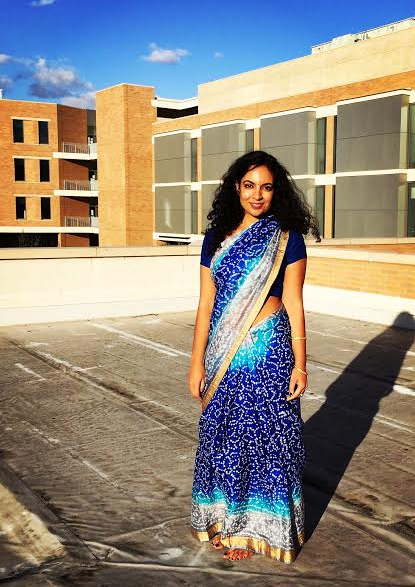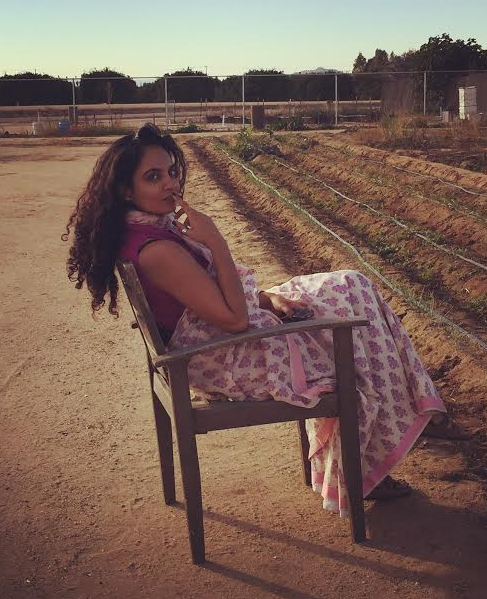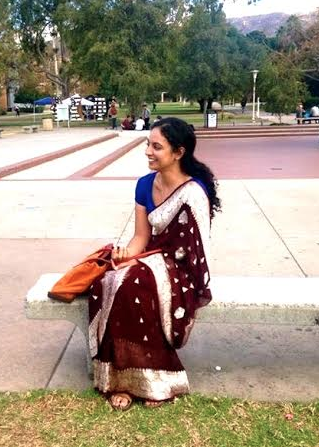I’ll let you in on a secret: I am brown, I am Indian, and I am American. English is my first language, but I also speak broken Hindi, and understand a bit of Punjabi and Bhojpuri. Most days, I wear a t-shirt and leggings and when I go to work, a dress. When I go to a wedding or an Indian event, I typically wear a saree, but infuse it with a bit of a Western touch.
The cool thing is, I am surrounded by people who are just like me. This is all quite normal for us.
But unfortunately, there are many people in this country who think that people like me—brown people—are a threat to them in some shape or form. They mistake us for terrorists. And while I can’t say I have ever publicly taken a stand on this issue, I’ve watched as a revolution to change this way of thinking has started within my own family.
 My cousin, Tanya Rawal, has created the ‘Saree, Not Sorry’ project, a movement designed to battle xenophobia through Indian fashion. Tanya, a native of Baton Rouge, Louisiana, is a Jack of All Trades; a recent PhD graduate in Comparative Literature, she has taught courses at Delhi University and UC Riverside. She has studied Bharatnatyam, Kathak, and Yoga. She has taught Bollywood dance classes. She dreams in Hinglish. And she has had a front row view of anti-immigration sentiment in the United States.
My cousin, Tanya Rawal, has created the ‘Saree, Not Sorry’ project, a movement designed to battle xenophobia through Indian fashion. Tanya, a native of Baton Rouge, Louisiana, is a Jack of All Trades; a recent PhD graduate in Comparative Literature, she has taught courses at Delhi University and UC Riverside. She has studied Bharatnatyam, Kathak, and Yoga. She has taught Bollywood dance classes. She dreams in Hinglish. And she has had a front row view of anti-immigration sentiment in the United States.
I’m proud to say that Tanya is fighting back through the ‘Saree, Not Saree’ movement, which uses fashion as a type of language to combat the rising xenophobic discourse in West. Tanya believes that in this day and age, it is time we stop feeling as though we must apologize for our skin color, language and culture. No one in the world should have to ever explain why they left their home. It’s never an easy choice for any of us.
We sat down for an exclusive interview with Tanya on fashion, identity, and above all, respecting the saree.
-Bhavna Singh

Tell us about some of your personal experiences with Indian fashion as an Indian American growing up in the U.S.
I didn’t have the language for my politics when I was a kid, but I was able to express my thoughts through fashion. And my thought process was focused on figuring out how to be hyphenated. I think when I was younger I found that using Indian fabrics with traditional western designs was a little subversive, and also an example of a hyphenated aesthetic. I remember designing a simple dress when I was about 11 years old. And my seamstress in India kept pushing me to complicate the pattern, but I was more focused on having a simple cut in order to emphasize the details of the deep red raw silk that I was using.
I always had fun with Indian fashion. I wore a black saree to a high school formal. But I didn’t drape it like a traditional saree…I found a black sequin tube top and my mom designed the drape. She actually had to stitch me into the saree!
In many ways the Saree, Not Sorry Project is just me being me.
As I got older there was a certain criticism embedded in my fashion choices. And the critique was actually directed at the Indian-Americans who were trying too hard to be white. But I was also critiquing people that couldn’t handle my difference. In high school my English teacher sent me home when I came to class one day with a pierced nose. She claimed it was disruptive. I came back to school the next day with about ten different paintings and textbooks with images of Sita. In each of them her nose was pierced. So I claimed freedom of religion.
Did any of those experiences play a part in shaping your identity or your approach to this project?
My experiences with Indian fashion definitely played a role in developing #SareeNotSorry! I learned a lot about India through the Ikat and bandhani dyeing techniques, the punjabi phulkari work, and India’s famous blockprint designs. But I learned a lot more from the way these designs and fabrics started conversations and, in some cases, incited side-eyes.
I am trained in comparative literature, which means I study and compare language. Fashion is a language. Fashion communicates. Fashion speaks and expresses a person’s desires to the rest of the world.

The Saree Not Sorry Project is an attempt to speak back to the anti-immigration sentiments we keep hearing in the United States. And to speak back minority communities need to get to know themselves. A great way to get to know yourself is to mediate how you are perceived, which you can do through fashion.
I am an advocate for solidarity amongst minority groups. The only way to actualize solidarity, however, is if all the minority groups get to know themselves first and in a way that does not encourage segregation. Fashion, like music and art, can be shared; it lends itself to collaboration and mutual understanding.
Indian-Americans (like other minorities) need to figure out how to celebrate the languages, histories, and aesthetics that make us Indian-American. And we need to get to know ourselves without relying on the language of other minorities. With our own language–our own fashion and rhythm–we will be able to help other communities understand our culture as well.
How would you describe the climate surrounding immigration discussions in the U.S. today?
Unpleasant. When people in the U.S. imagine an immigrant, the image of a brown person most likely comes to mind. The immigration question is not simply about who is and is not legal. It’s not all about having the right papers. The immigration debate rests on the idea that some people look illegal and some people look legal. I was born in this country, but I am illegal-looking.
I hear a lot of white people saying that they are not worried about indian immigrants, because Indians are the “good ones.” My response: if we are so good, why shoot up a gurdwara? why spend extra time checking my hair at the airports? why is it necessary to attack an Indian grandfather in Alabama?
On paper, maybe some Indian-Americans fit the criteria of being “good.” But Indians are not perceived as “good.” The fact is that all brown people look the same to most white people. And throughout the globe brown means bad and dangerous.
Have you noticed a shift in attitude toward immigrants from what you experienced growing up?
The easiest answer to this is yes, of course, things have changed. Especially for brown people post-9/11. But an easy yes would also contribute to forgetting the Dotbusters of New Jersey in the 80s, the curry jokes, dirty Hindu labels, and the Apu – ‘thank you come again’ performances. All of these physically and verbally violent practices were in place before 9/11. 9/11 simply justified all the violence against brown people. The ‘war on terror’ needs someone to be a terrorist.
Consequently, all brown people have become potential terrorists. And not just in the United States, but across the globe. I was once accused of being a terrorist in India. In Banaras a police officer thought I was Pakistani and, therefore, would not allow me to enter a Hindu temple… This is terrifying! I’m way too ‘wheatish’ for this to not be terrifying for me!
What part do you think that fashion plays in helping define someone’s identity?
Your fashion is an expression of the things that attract you. And fashion, like skin color, is the first thing other people see. Fashion is a mode of communication with the rest of the world. Fashion can reveal a truth about you, but it can also lie for you. Fashion discloses subtle characteristics about a person and it can be a way to convey your politics. So I think people can use fashion to transmit information to their communities and the strangers we encounter everyday. And I think your identity, which is probably always changing, develops in conversation.
With the Saree, Not Sorry project specifically, what type of changes do you believe you can bring about through fashion? How can fashion and other forms of self-presentation be used to create a more in-depth dialogue on the topic of immigration and identity politics?
I think the Saree Not Sorry Project can create a space for Indian youth across the globe to unite. For Indians in America to understand themselves, they need to build relationships with India and their peers in India. And I think fashion is a great point of entry for Indian-Americans. I also think this project has appeal in India as well. In India the saree has lost its swag. I lived in India on and off for the last several years and I rarely saw young women in a saree. This is not because the saree is hard to wear, it is actually quite comfortable…
 #Sareenotsorry creates a more in-depth dialogue on the topic of immigration because the project supports any refusal to apologize for being brown, black, or other. I’m not sorry for being brown and I will never apologize for it. For several years now Muslim women have been told to stop wearing their hijab and Muslim men have been told to shave their beards. Sikhs are always told to stop wearing the turban. I have also been told to ‘be careful’ when I wear a saree. This is the wrong conversation. Instead of telling a woman in a saree to be careful, we need to be talking to and educating the people that use the saree or the hijab as an excuse to be violent.
#Sareenotsorry creates a more in-depth dialogue on the topic of immigration because the project supports any refusal to apologize for being brown, black, or other. I’m not sorry for being brown and I will never apologize for it. For several years now Muslim women have been told to stop wearing their hijab and Muslim men have been told to shave their beards. Sikhs are always told to stop wearing the turban. I have also been told to ‘be careful’ when I wear a saree. This is the wrong conversation. Instead of telling a woman in a saree to be careful, we need to be talking to and educating the people that use the saree or the hijab as an excuse to be violent.
Women in sarees or hijabs and men in turbans are not asking for violent responses. Just like a woman in a short skirt is not asking to be raped. In comparing these two discursive practices, however, we can really see how white supremacy and patriarchy feed each other.
When a person is told to shave off their beard, straighten their hair, or not wear a piece of clothing that they like, they are being told to assimilate. Assimilation means to “become like.” But for me to ‘become like’ the people that turn to violence at the sight of hijabs, sarees, and turbans would mean that I would have to hate myself. I would have to become scared of myself. I am not able to do that. And my question to this line of thinking is: where do we draw the line on assimilation? Should we all start bleaching our skin too?
What do you think of resistance to wearing sarees and other decorative cultural items within the South Asian community? There is a belief by some that being in touch with your culture makes you a ‘FOB’ and somehow actually denotes a lack of worldliness. How can that perception be combatted, both within a community and outside of it?
I think this is a shame. Our grandmothers were rocking crop tops before American Apparel made it cool. I think the resistance comes from this deep desire to fit in and blend. And if you agree with the politics of the culture you are trying to blend into then I say go for it. Bobby Jindal, for example, makes more sense in a business suit than in a dhoti (bless his heart). But I have never been in a position to endorse American culture. The United States does not have my back. So I don’t feel like it is a good idea for me to wear its uniform.
Indian fashion can be identified across the globe. Let’s think about it like this….those popular crop tops sold at every store right now are eerily similar to a saree blouse. (In fact I wore a red billabong crop top with one of my sarees) And the legging craze with the long blouse is nothing other than a modified churidar and kameez. India might not know how to colonize other nations, but we have been influencing fashion for a long time. And I think it is time we get credit for our beautiful contributions to the world.
Also, the idea that Indians wearing Indian fashion denotes a lack of worldliness is in itself an unsophisticated idea. And the remedy for this type of thinking might just come from projects like #sareenotsorry. More South Asians need to get out there and be creative.
Some believe that more visibility of sarees, bindis, and other similar adornments will lead to cultural appropriation. Where do you personally draw the line between sharing your culture and having it stolen?
Profit. Money. That is where I draw the line. Culture is stolen when the wrong people are making a profit. I think anyone has the right to wear a saree. In fact, I encourage people to wear South Asian clothes. Plus, sharing is caring.

I’m just not okay with non-South Asians profiting from our fabrics. India already dealt with this once, we don’t need to do it again. But, as history suggests, we can always prove that we know how to do it better if it comes to that!
Is there any concern from your end that emphasizing fashion in the discussion of cultural identity could lead to appropriation?
If some non-South Asians feel compelled to run out and buy a saree or wear a bindi because they see me doing it then I hope they choose to go to an indian-owned store and buy their goodies. Fashion is political, which means that consuming fashion is also political. We need to understand where our clothes are coming from.
And I don’t think Indian aesthetics can get lululemoned. Yoga pants and mats are easy to develop. Indian fashion, on the other hand, is a lived experience, it is not singular, and it is always growing. The subcontinent has thousands of aesthetic distinctions that can’t be mass produced.
If you had to give a piece of advice to other young Indian Americans struggling with their identity, particularly young women, what would it be?
Respect your grandmothers, mothers, and aunts. One thing I love about Indian women is their dedication to self-care. In India you will find the poorest women living on the streets putting oil in their hair on a sunny afternoon. You have to love and take care of yourself, because nobody will ever be able to do this for you. And in these practices of self-care you start to understand your “identity.” That is, when you take your kajol off at night you begin to analyze why you put it on that day. When you wash your face with milk and turmeric to remove the layer of dirt that sits on your skin you can ask yourself what else you need to remove from your life in order to bring more beauty and happiness to the surface. Through practices of self-care and the pursuit of health you can figure out what is important to you and what you need. And then you can figure out how to translate your desires to the world.
Also, always remember that brown is beautiful. Go out in the sun and soak up that vitamin D. Never apologize for your brown skin.
You can read more about the Saree, Not Sorry project here. You also can track Tanya’s progress on Instagram and Twitter.
This piece was a collaborative effort by Brooke Anderson and Bhavna Singh.
